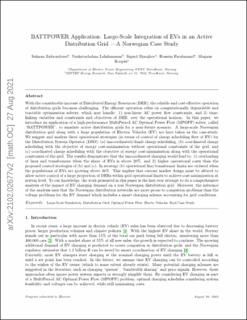| dc.contributor.author | Zaferanlouei, Salman | |
| dc.contributor.author | Lakshmanan, Venkatachalam | |
| dc.contributor.author | Bjarghov, Sigurd | |
| dc.contributor.author | Farahmand, Hossein | |
| dc.contributor.author | Korpås, Magnus | |
| dc.date.accessioned | 2023-03-16T09:37:53Z | |
| dc.date.available | 2023-03-16T09:37:53Z | |
| dc.date.created | 2022-03-25T13:09:06Z | |
| dc.date.issued | 2022 | |
| dc.identifier.issn | 0378-7796 | |
| dc.identifier.uri | https://hdl.handle.net/11250/3058667 | |
| dc.description.abstract | With the considerable increase of Distributed Energy Resources (DER), reliable and cost-effective operation of distribution grids becomes challenging. The efficient operation relies on computationally dependable and tractable optimisation solvers, which may handle: 1) non-linear AC power flow constraints, and 2) time-linking variables and constraints and objectives of DER, over the operational horizon. In this paper, we introduce an application of a high-performance MultiPeriod AC Optimal Power Flow (MPOPF) solver, called “BATTPOWER”, to simulate active distribution grids for a near-future scenario. A large-scale Norwegian distribution grid along with a large population of Electric Vehicles (EV) are here taken as the case-study. We suggest and analyse three operational strategies (in terms of control of charge scheduling fleet of EV) for the Distribution System Operator (DSO): (a) uncoordinated charge scheduling, (b) coordinated charge scheduling with the objective of energy cost-minimisation without operational constraints of the grid, and (c) coordinated charge scheduling with the objective of energy cost-minimisation along with the operational constraints of the grid. The results demonstrate that the uncoordinated charging would lead to: 1) overloading of lines and transformers when the share of EVs is above 20%, and 2) higher operational costs than the proposed control strategies of (b) and (c). In strategy (b) operational line/transformer limits are violated when the populations of EVs are growing above 36%. This implies that current market design must be altered to allow active control of a large proportion of DERs within grid operational limits to achieve cost minimization at system level. To our knowledge, the work presented in this paper is the first ever attempt to do a comprehensive analysis of the impact of EV charging demand on a real Norwegian distribution grid. Moreover, the inference of the analysis says that the Norwegian distribution networks are more prone to congestion problems than the voltage problems for the EV demand which includes a smart charging scheme accounting for grid conditions. | en_US |
| dc.language.iso | eng | en_US |
| dc.publisher | Elsevier | en_US |
| dc.title | BATTPOWER application: Large-scale integration of EVs in an active distribution grid – A Norwegian case study | en_US |
| dc.title.alternative | BATTPOWER application: Large-scale integration of EVs in an active distribution grid – A Norwegian case study | en_US |
| dc.type | Journal article | en_US |
| dc.description.version | submittedVersion | en_US |
| dc.source.volume | 209 | en_US |
| dc.source.journal | Electric power systems research | en_US |
| dc.identifier.doi | 10.1016/j.epsr.2022.107967 | |
| dc.identifier.cristin | 2012567 | |
| dc.relation.project | Norges forskningsråd: 257626 | en_US |
| dc.relation.project | Norges forskningsråd: 309997 | en_US |
| dc.relation.project | Norges forskningsråd: 295133 | en_US |
| cristin.ispublished | true | |
| cristin.fulltext | preprint | |
| cristin.qualitycode | 1 | |
